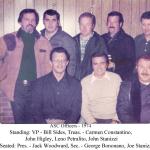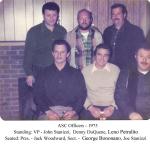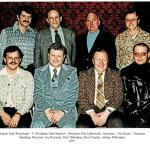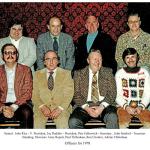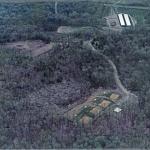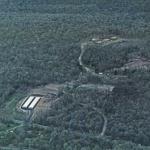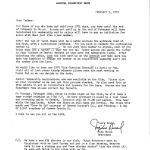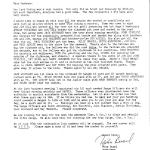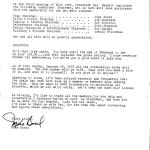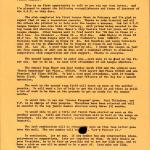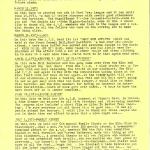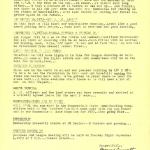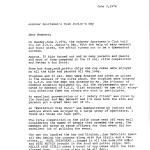The Origin and History of the
Andover Sportsman's Club
Andover, Connecticut
1970s
 The early 1970s was a busy time for the club. In 1971 the club cleared and bulldozed its first rifle range, as well as built a 20ft by 12ft shelter there. This was the first facility constructed on the south side of the railroad tracks. Concrete pathways were poured on the trap field behind the club house, the upstairs of the club house was refinished and the club house electrical service was upgraded to 200amps. The club's first official trap league was held in the fall (the fall 2011 league is the eightieth league). This same year the Board of Directors felt it was necessary to outlaw gambling on shooting, which apparently had become quite prevalent, and to outlaw all gambling on shooting nights. The year closed with the property owners approving the installation of a second trap field and a storage shed. Membership at the time cost $18 annually, with a $36 initiation fee.
The early 1970s was a busy time for the club. In 1971 the club cleared and bulldozed its first rifle range, as well as built a 20ft by 12ft shelter there. This was the first facility constructed on the south side of the railroad tracks. Concrete pathways were poured on the trap field behind the club house, the upstairs of the club house was refinished and the club house electrical service was upgraded to 200amps. The club's first official trap league was held in the fall (the fall 2011 league is the eightieth league). This same year the Board of Directors felt it was necessary to outlaw gambling on shooting, which apparently had become quite prevalent, and to outlaw all gambling on shooting nights. The year closed with the property owners approving the installation of a second trap field and a storage shed. Membership at the time cost $18 annually, with a $36 initiation fee.
 By the middle of 1972, the second trap field was up and running. The new field was constructed between the rifle range and the railroad tracks. A new tap machine was purchased for this field at a cost of $600. This new field was arranged such that some of the birds were actually thrown over the railroad tracks. About the same time that the new field came into use, it was decided to pay members that worked the trap house $1 per round. At this time, the “trap boys” duty was to place a clay pigeon onto the trap arm. Cocking and tripping the trap were automated.
By the middle of 1972, the second trap field was up and running. The new field was constructed between the rifle range and the railroad tracks. A new tap machine was purchased for this field at a cost of $600. This new field was arranged such that some of the birds were actually thrown over the railroad tracks. About the same time that the new field came into use, it was decided to pay members that worked the trap house $1 per round. At this time, the “trap boys” duty was to place a clay pigeon onto the trap arm. Cocking and tripping the trap were automated.
 A new 5 year lease between the club and the property owners took effect in January, 1973. This new least was virtually identical to the 1968 lease with rent set at $600 per year plus the club would be responsible for all property taxes. This same year, the club agreed to approach the property owners about putting an addition on the club house. The idea of expanding the building was quite controversial as the club would be expending considerable effort and expense on something they did not own. Permission was received for the club to proceed with their plans for an addition that would measure 18ft x 28ft, roughly doubling the size of the building. Excavation for the foundation began in early October. Blasting was necessary to complete the excavation, but this did not cause much of a delay as the foundation was poured and ready to be capped for the winter by November 10th. With members providing the labor and much of the needed materials, the addition was completed in 1974.
A new 5 year lease between the club and the property owners took effect in January, 1973. This new least was virtually identical to the 1968 lease with rent set at $600 per year plus the club would be responsible for all property taxes. This same year, the club agreed to approach the property owners about putting an addition on the club house. The idea of expanding the building was quite controversial as the club would be expending considerable effort and expense on something they did not own. Permission was received for the club to proceed with their plans for an addition that would measure 18ft x 28ft, roughly doubling the size of the building. Excavation for the foundation began in early October. Blasting was necessary to complete the excavation, but this did not cause much of a delay as the foundation was poured and ready to be capped for the winter by November 10th. With members providing the labor and much of the needed materials, the addition was completed in 1974.
 The cost of a round of trap in 1974 was increased to $1.50
The cost of a round of trap in 1974 was increased to $1.50
 Club dues were raised for 1975 to $20, and the initiation fee was raised to $22. By mid-1975, the club was concerned that membership growth was overloading the facilities, so it was decided to cap the membership at 150 senior members, which was the membership level at the time.
Club dues were raised for 1975 to $20, and the initiation fee was raised to $22. By mid-1975, the club was concerned that membership growth was overloading the facilities, so it was decided to cap the membership at 150 senior members, which was the membership level at the time.
 With the current lease about to expire, the club approached the property owners in early 1977 about the possibility of the club acquiring the property. As a result, Dick Selig Realty was engaged to appraise the assets of ASC Inc (the owners). so that a fair price could be set for the owners stock and the property as a whole. The appraisal came in at $88,500 or $18,500 for the building, and $70,000 for the land. Feeling that this appraisal was on the low side, but also recognizing that the club had made a considerable investment in expanding and refurbishing the club house, the owners offered the club the property for $90,000. At the same time, after considering the costs associated with selling the property and the fact that the stock provided no income to its holder, the owners set the value of the 694 outstanding shares of ASC, Inc. stock at $75 per share. In October, the club officially notified the owners that they would not be able to buy the property at that time, but that there were a number of members that would like to buy any stock that the owners might offer for sale. By the end of the year, club members held 63 of the 694 outstanding shares of ASC, Inc. Since the club was not in a position to purchase the property at this time, a new 5 year lease was executed. The new lease stipulated that the club would pay $300 per year in rent as well as being responsible for paying all taxes and carrying adequate insurance.
With the current lease about to expire, the club approached the property owners in early 1977 about the possibility of the club acquiring the property. As a result, Dick Selig Realty was engaged to appraise the assets of ASC Inc (the owners). so that a fair price could be set for the owners stock and the property as a whole. The appraisal came in at $88,500 or $18,500 for the building, and $70,000 for the land. Feeling that this appraisal was on the low side, but also recognizing that the club had made a considerable investment in expanding and refurbishing the club house, the owners offered the club the property for $90,000. At the same time, after considering the costs associated with selling the property and the fact that the stock provided no income to its holder, the owners set the value of the 694 outstanding shares of ASC, Inc. stock at $75 per share. In October, the club officially notified the owners that they would not be able to buy the property at that time, but that there were a number of members that would like to buy any stock that the owners might offer for sale. By the end of the year, club members held 63 of the 694 outstanding shares of ASC, Inc. Since the club was not in a position to purchase the property at this time, a new 5 year lease was executed. The new lease stipulated that the club would pay $300 per year in rent as well as being responsible for paying all taxes and carrying adequate insurance.
 The cost of a round of trap in 1976 was increased to $1.75
The cost of a round of trap in 1976 was increased to $1.75
1980s
 The early 1980s saw the club more determined than ever to gain ownership of the ASC, Inc. property. A committee was established to meet with the owners to discuss options for taking ownership of the land. The club reported having $10,000 in its building fund that could be used to get things moving. At the first meeting between the club’s committee and the owners, it was agreed to get a new appraisal of the property done. The club prepared a list of potential appraisers, from which the committee and the owners agreed to hire the John F. Rowlson Company to do the work. Early in 1981 the appraisal was delivered and gave the property a market value of $118,500. But as the work was not done per the instructions given, neither the club nor the owners were happy with it. Without any new useful information, the club went to the owners with an offer to buy all of the shares that club members did not already own at $75 per share, effectively valuing the property at $52,050. The majority owners simply replied “no.” Not to be deterred, the club next decided to try and appeal directly to the individual stock holders with an offer of $125 per share. The club got three responses, two “no’s” and one “ok, but at $150 per share.” The club committee persisted and by October, the majority owners had agreed to allow the club and its members to purchase as much stock as they could at $125 per share, with the understanding that a small group of the original share holders would retain a controlling interest in ASC, Inc. until such time as the club could buy all of their stock at once.
The early 1980s saw the club more determined than ever to gain ownership of the ASC, Inc. property. A committee was established to meet with the owners to discuss options for taking ownership of the land. The club reported having $10,000 in its building fund that could be used to get things moving. At the first meeting between the club’s committee and the owners, it was agreed to get a new appraisal of the property done. The club prepared a list of potential appraisers, from which the committee and the owners agreed to hire the John F. Rowlson Company to do the work. Early in 1981 the appraisal was delivered and gave the property a market value of $118,500. But as the work was not done per the instructions given, neither the club nor the owners were happy with it. Without any new useful information, the club went to the owners with an offer to buy all of the shares that club members did not already own at $75 per share, effectively valuing the property at $52,050. The majority owners simply replied “no.” Not to be deterred, the club next decided to try and appeal directly to the individual stock holders with an offer of $125 per share. The club got three responses, two “no’s” and one “ok, but at $150 per share.” The club committee persisted and by October, the majority owners had agreed to allow the club and its members to purchase as much stock as they could at $125 per share, with the understanding that a small group of the original share holders would retain a controlling interest in ASC, Inc. until such time as the club could buy all of their stock at once.
 In 1980, following the death of long time member Ray Stanizzi, the club created the Ray Stanizzi Memorial Fund. This is a fund to benefit the families of deceased active members. This fund was set up to have a maximum value of $1,000, with payouts from the fund being made upon the authorization of any club officer. Each year a benefit shoot is held to support the fund. 1980 was also the year that the club approved a by-laws change that moved the club from directly electing its officers, to instead electing an eleven member Board of Directors. The BOD then chose a Chairman, Vice Chairman, Secretary, and Treasurer from among their number. The BOD is to run the club collectively, with each board member chairing at least one club committee. At this time the Club raised the membership limit to 200. The next year brought an increase in the membership fees. Dues were raised to $30 per year which was to be split between the general fund - $20 and the building fund - $10. The initiation fee was also set at $30 and was to be split the same way between the two funds. It was further decided that the amount of general receipts going to the building fund would be reduced from 15% to 8%.
In 1980, following the death of long time member Ray Stanizzi, the club created the Ray Stanizzi Memorial Fund. This is a fund to benefit the families of deceased active members. This fund was set up to have a maximum value of $1,000, with payouts from the fund being made upon the authorization of any club officer. Each year a benefit shoot is held to support the fund. 1980 was also the year that the club approved a by-laws change that moved the club from directly electing its officers, to instead electing an eleven member Board of Directors. The BOD then chose a Chairman, Vice Chairman, Secretary, and Treasurer from among their number. The BOD is to run the club collectively, with each board member chairing at least one club committee. At this time the Club raised the membership limit to 200. The next year brought an increase in the membership fees. Dues were raised to $30 per year which was to be split between the general fund - $20 and the building fund - $10. The initiation fee was also set at $30 and was to be split the same way between the two funds. It was further decided that the amount of general receipts going to the building fund would be reduced from 15% to 8%.
 On January 1, 1983 a new property lease went into effect. The annual rent would be $500 plus the club was responsible for taxes and insurance. This lease was a bit different than the previous ones in that this lease had a specific buyout provision. The club could buy the property out right for $100,000 in 1983, for $105,000 in 1984 and for $110,000 in 1985. The stock price was held at $125 per share, with club members now holding 126 shares or a little over 18% of the outstanding shares. Club members continued to purchase stock throughout 1984 and 1985, accumulating a total of 259 shares by December of 1985. At this time the same group of original share holders that held the other 435 shares, sold all but 28 shares to the club and its members at $155 per share. The club itself purchased 290 share. The 28 shares not sold to the club were distributed by the original holders to their descendants.
On January 1, 1983 a new property lease went into effect. The annual rent would be $500 plus the club was responsible for taxes and insurance. This lease was a bit different than the previous ones in that this lease had a specific buyout provision. The club could buy the property out right for $100,000 in 1983, for $105,000 in 1984 and for $110,000 in 1985. The stock price was held at $125 per share, with club members now holding 126 shares or a little over 18% of the outstanding shares. Club members continued to purchase stock throughout 1984 and 1985, accumulating a total of 259 shares by December of 1985. At this time the same group of original share holders that held the other 435 shares, sold all but 28 shares to the club and its members at $155 per share. The club itself purchased 290 share. The 28 shares not sold to the club were distributed by the original holders to their descendants.
1984 brought about a name change for the club. I was decided that the name of the club should be "Andover Sportman's Club, Inc." Having assumed the credentials of the original club, instead of filing as a new group in 1966, the official name of the club had been "The Andover Sportmen Club, Incorporated."
 Now that the club and its members held most of the shares of stock in A.S.C. Incorporated, the club decided to make is a requirement that each member must own at least one share of the stock in order to renew their membership for 1987. This was necessary to replenish the club treasury as the clubs funds were all tied up in the stock that it held. By requiring each member to own a share, the amount of stock that the club was holding would be reduced thus freeing the capital for other projects.
Now that the club and its members held most of the shares of stock in A.S.C. Incorporated, the club decided to make is a requirement that each member must own at least one share of the stock in order to renew their membership for 1987. This was necessary to replenish the club treasury as the clubs funds were all tied up in the stock that it held. By requiring each member to own a share, the amount of stock that the club was holding would be reduced thus freeing the capital for other projects.
 The cost of a round of trap in 1987 was increased to $2.00.
The cost of a round of trap in 1987 was increased to $2.00.
 In 1987, A.S.C., Inc. did a land swap with the owners of Andover Self Storage principals as it was found that a significant portion of the club house parking lot was not owned by A.S.C., Inc. After some discussions, it was determined that the Andover Self Storage principals needed to access the electrical power lines that run on the A.S.C., Inc. property. The club agreed to allow access to the power lines if the Andover Self Storage principals agreed to swap the parking lot land for some land along the power lines and to pay the club a $2,000 fee.
In 1987, A.S.C., Inc. did a land swap with the owners of Andover Self Storage principals as it was found that a significant portion of the club house parking lot was not owned by A.S.C., Inc. After some discussions, it was determined that the Andover Self Storage principals needed to access the electrical power lines that run on the A.S.C., Inc. property. The club agreed to allow access to the power lines if the Andover Self Storage principals agreed to swap the parking lot land for some land along the power lines and to pay the club a $2,000 fee.
 1988 was a year great change for the club. In January the BOD approved the recommendation of the Trap Field Relocation Committee as to the selection of a site to build a new set of fields. The land was cleared and by December the foundation of the new (upper) club house was poured and capped. The club also voted to spend $4,500 to improve the rifle range. A contract was signed with Countryside Homes to do the bulldozing for the range. Almost immediately solid ledge was encountered. This led to the need to hire a second contractor to finish the job and made the final cost of the project $7,030, or $2,350 over the initial budget. To help pay for the new trap fields, new club house and other improvements, the club signed a contract with the Rossi Corporation to have the property logged. This contract added $23,186 to the treasury. Along with these activities, the club decided to implement a work requirement for members. Beginning in 1989, members would be required to provide 12 hours of work toward the good of the club, or pay double dues. It was also decided that beginning with 1989 dues would be raised to $50, from $40.
1988 was a year great change for the club. In January the BOD approved the recommendation of the Trap Field Relocation Committee as to the selection of a site to build a new set of fields. The land was cleared and by December the foundation of the new (upper) club house was poured and capped. The club also voted to spend $4,500 to improve the rifle range. A contract was signed with Countryside Homes to do the bulldozing for the range. Almost immediately solid ledge was encountered. This led to the need to hire a second contractor to finish the job and made the final cost of the project $7,030, or $2,350 over the initial budget. To help pay for the new trap fields, new club house and other improvements, the club signed a contract with the Rossi Corporation to have the property logged. This contract added $23,186 to the treasury. Along with these activities, the club decided to implement a work requirement for members. Beginning in 1989, members would be required to provide 12 hours of work toward the good of the club, or pay double dues. It was also decided that beginning with 1989 dues would be raised to $50, from $40.
 The 1980s closed with the club making its first honorary members. Paul Prevost, Jack Woodward and Pete Falkowich were so honored for their exceptional service rendered to the club. By the end of 1989, it was also reported that work on the new club house had progressed to the point where the building had a roof.
The 1980s closed with the club making its first honorary members. Paul Prevost, Jack Woodward and Pete Falkowich were so honored for their exceptional service rendered to the club. By the end of 1989, it was also reported that work on the new club house had progressed to the point where the building had a roof.
This 1989 aerial photograph shows the original trap field behind the lower club house (lower left) and the second trap field (new in 1972) across the Railroad ROW (center).
To view these newletters, click on any of the small versions.
1989 aerial views of the club property
Some 1970s / 1980s Club Officers
To view these photos full size, click on any of the small versions.
To view these photos full size, click on any of the small versions.



